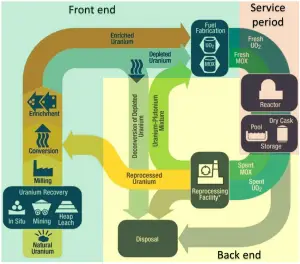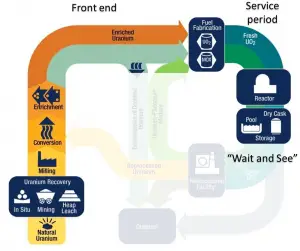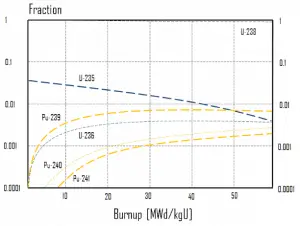
The nuclear fuel cycle is a process chain consisting of various stages. The nuclear fuel cycle starts with the mining of uranium and ends with the disposal of nuclear waste. The stages form a true cycle with the reprocessing of used fuel as an option for nuclear energy. In general, the nuclear fuel cycle consists of steps in the front end (the preparation of the fuel), steps in the service period (fuel burnup), and steps in the back end (reprocessing or disposal of spent nuclear fuel).
- The front end of the nuclear fuel cycle. The front end of the nuclear fuel cycle starts with the mining of uranium in the mines and ends with the delivery of the enriched uranium to the nuclear fuel assembly producer. Therefore, the front end of the fuel cycle consists of:
- Uranium mining, milling and mill tailings,
- Conversion
- Fuel enrichment
- Fabrication of fuel assemblies
- Service Period. The service period includes transport of fuel assemblies within a power plant, in-core fuel management, fuel utilization, and storage in the spent fuel pool.
- The back end of the nuclear fuel cycle. The back end of the nuclear fuel cycle involves managing the spent fuel after irradiation. Therefore, the back end of the fuel cycle consists of:
- spent interim fuel storage
- fuel reprocessing,
- final disposal of radioactive waste or spent fuel.
Open Fuel Cycle – Once-through Fuel Cycle

Most countries with nuclear programs use some type of interim storage as their back-end strategy. They have explicitly decided to take a “wait and see” approach to spent fuel management, leaving their spent fuel in interim storage, which leaves both the reprocessing and direct disposal options open for the future. As the name implies, the wait-and-see option proposes interim storage until some solution for permanent storage and disposal will be developed in the future. For many operators, the spent fuel also represents a strategic material since the spent nuclear fuel still contains about 96% of reusable material. Storing spent fuel and waste for several years allows heat release and radioactivity to subside. Despite the continued debate over the future of the fuel cycle, a quiet consensus has developed that simply storing spent fuel while developing more permanent solutions is an attractive approach for the near term. Currently, spent fuel is being stored in at-reactor (AR) or away-from-reactor (APR) storage facilities, and we can identify two basic solutions for interim storage:
- Dry Storage
- Wet Storage
Closed Fuel Cycle
A closed fuel cycle is an advanced fuel cycle whose purpose is to achieve nuclear power sustainability by reducing the final waste’s radiotoxicity and improving resource utilization while maintaining economic viability. There are currently different types of advanced fuel cycles under research, but most of them are based on the use of:
- Advanced Nuclear Reactors
- Fuel Reprocessing
Most closed fuel cycles have something in common: they are based on partitioning and transmutation and a combination of light water reactors and breeder reactors. For example, a future closed fuel cycle could be based on advanced hard-spectrum LWRs rather than the traditional fast neutron reactors. A fast neutron reactor is a nuclear reactor in which the fission chain reaction is sustained by fast neutrons. That means the neutron moderator (slowing down) in such reactors is undesirable. This is a key advantage of fast reactors because fast reactors have a significant excess of neutrons (due to low parasitic absorption), unlike PWRs (or LWRs).
In all cases, the fuel assemblies are first after irradiation stored in spent fuel pools at the reactor site for an initial cooling period. Over time, as the spent fuel is stored in the pool, it becomes cooler as the radioactivity decays away. After several years (> 5 years), decay heat decreases under specified limits so that spent fuel may be reprocessed.
Fuel reprocessing is based on the fact that the removed fuel from LWRs (spent nuclear fuel) still contains about 96% of reusable material. It must be removed due to decreasing kinf of an assembly, or in other words, it must be removed due to accumulation of fission products with significant absorption cross-section.

In summary, the following points are the main isotopic changes for fuel at fuel burnup of 40 GWd/tU:
- Approximately 3 – 4% of the heavy nuclei are fissioned.
- This 3 – 4 % are then fission fragments, more or less
- About two-thirds of these fissions come directly from uranium 235, and the other third from plutonium, which is produced from uranium 238. The contribution significantly increases as the fuel burnup increases.
- Approximately 96–97% of its components are recyclable materials, 94–96% of which is uranium.
- Discharged fuel contains about 0.8% plutonium and about 1% uranium 235. It must be noted that there is a significant content (about 0.5%) of uranium 236, which is neither a fissile isotope nor a fertile isotope.
Thus, to exploit its energy potential, the spent nuclear fuel has to be put through a series of chemical processes known as reprocessing. Therefore, the closed cycle strategy assumes that the spent nuclear fuel will be reprocessed to extract the uranium and plutonium, which can be recycled as fresh nuclear fuel for use in a nuclear reactor adapted to this type of fuel. As in all cases, the fuel assemblies are first after irradiation, stored in spent fuel pools at the reactor site for an initial cooling period. Over time, as the spent fuel is stored in the pool, it becomes cooler as the radioactivity decays away. After several years (> 5 years), decay heat decreases under specified limits so that spent fuel may be transported to the reprocessing facility, where uranium and plutonium are separated from the minor actinides (MA) and fission products (FP) using the PUREX process, which is currently the only commercially available technology. Once they have been separated, the minor actinides and fission products are vitrified in a glass matrix and stored as high-level waste. Recovered uranium and plutonium can, if economic and institutional conditions permit, be recycled for use as nuclear fuel.
The uranium recovered from reprocessing, which typically contains a slightly higher concentration of uranium 235 than in nature, can be reused as fuel after conversion and enrichment.
The plutonium can be directly made into mixed oxide fuel (MOX fuel), in which uranium and plutonium oxides are combined. In reactors that use MOX fuel, plutonium substitutes for the U-235 in normal uranium oxide fuel.
It must be added that the final high-level waste volume is reduced by about 80%, its radiotoxicity decreases by about 90%, and its decay heat is reduced compared to the once-through cycle. This is because the spent fuel comprises more than 96% of U and Pu.
See also: Conversion Factor
See also: Neutron Flux – Uranium vs. MOX Fuel
Types of Nuclear Fuel Cycles
As was written, the back end of the nuclear fuel cycle involves managing the spent fuel after irradiation. Therefore, the back end of the fuel cycle consists of:
- spent interim fuel storage
- fuel reprocessing,
- final disposal of radioactive waste or spent fuel.
There are three main types of nuclear fuel cycle:
- Once-through fuel cycle. An open fuel cycle is not a real cycle, and this strategy assumes that the fuel is used once and sent to long-term storage without further reprocessing. If spent fuel is not reprocessed, the fuel cycle is referred to as an open fuel cycle or a once-through fuel cycle, as the uranium components go through the reactor once. The once-through cycle comprises two main back-end stages:
- interim storage
- final disposal.
- Twice-through fuel cycle. The twice-through cycle strategy assumes that the spent nuclear fuel will be reprocessed to extract the uranium and plutonium, which can be recycled as fresh nuclear fuel for use in a nuclear reactor adapted to this type of fuel.
- Closed fuel cycle. The closed fuel cycle is an advanced fuel cycle whose purpose is to achieve nuclear power sustainability by reducing the final waste’s radiotoxicity and improving resource utilization while maintaining economic viability. There are currently different types of advanced fuel cycles under research, but most of them are based on the use of:
- Advanced Nuclear Reactors
- Fuel Reprocessing
These fuel strategies are based on specific processes in the entire fuel cycle (the back end, the front end, and the service period). All these scenarios are theoretical, and the practical solution will be, in any case, a combination of these options. In all cases, the fuel assemblies are first after irradiation, stored in spent fuel pools at the reactor site for an initial cooling period. It must be added that any strategy for managing spent nuclear fuel will be built around combinations of many options, and all strategies must ultimately include permanent geological disposal.
The choices of nuclear fuel cycle (open, closed, or partially closed through limited spent fuel recycling) depend upon the technologies we develop and societal weighting of goals (safety, economics, waste management, and nonproliferation). Once choices are made, they will have major and long-term impacts on nuclear power development. Today we do not have sufficient knowledge to make informed choices for the best cycles and associated technologies.
See more: The Future of the Nuclear Fuel Cycle. An interdisciplinary MIT study. MIT, 2011. ISBN 978-0-9828008-4-3.